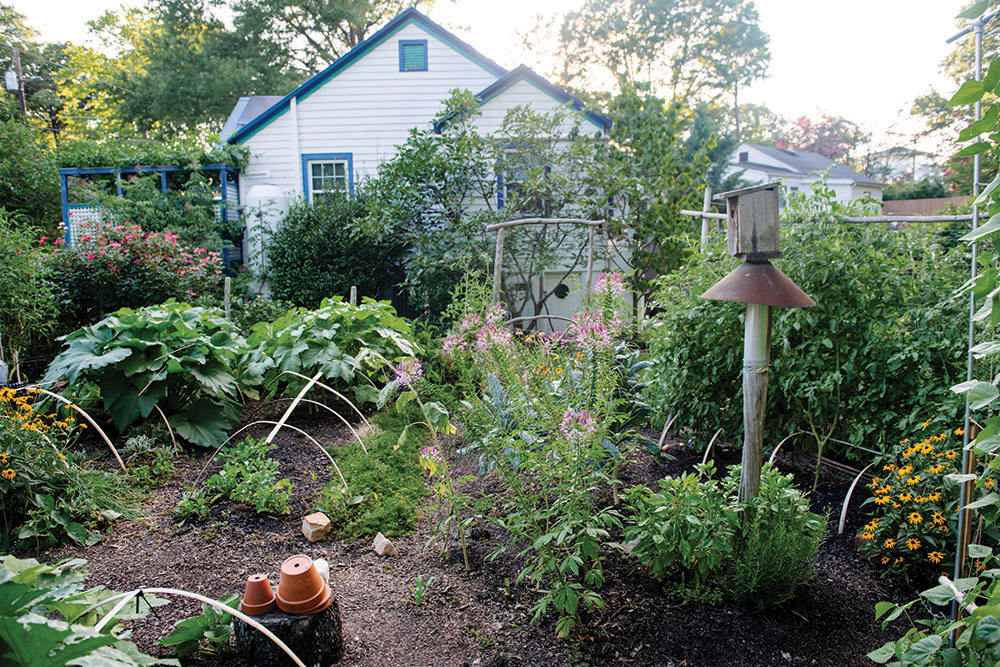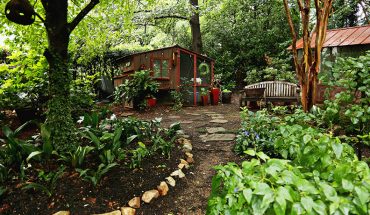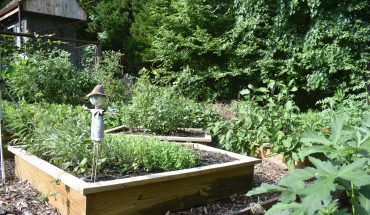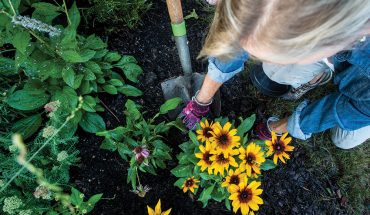Your monthly list of Oak City-specific tips on what to do in your garden right now.
by Tina Mast

The days are warming up, the hardwoods are starting to bloom, and we are headed into spring! There’s plenty to do but don’t forget to just sit out there and enjoy it all, too. I love to have a fire in the firepit on chilly spring evenings, break out the ukulele, and annoy, I mean, serenade the local wildlife and neighbors while soaking up the joy of seeing the plants wake up from winter. In the mornings, I wander glamorously in my bathrobe and mud boots sniffing flowers like the golden paperbush and fragrant winter daphne, picking lovely Lenten roses to float in a beautiful glazed bowl of water. Find your own garden rituals to celebrate the work you put in your landscape this month. And don’t forget about these things either.
Plant perennials, flowering trees and cool-season edibles
Now is a great time to establish trees and shrubs before the heat is on. Bear in mind that the average date of the last killing frost is around April 15th, and warm-season plants such as tender annuals and vegetables should be set out after this date. If planted earlier, be sure to protect them from low temperatures. Loads of fresh plants are coming into the nursery right now, so get ready to plant perennials, shrubs, flowering trees, and shade trees before it gets hot. Plant seedlings of cool-season crops such as broccoli, cabbage, greens, lettuce, and cauliflower up to four weeks before the last spring frost, and sow onion sets and seeds of carrots, peas, radishes, spinach, turnips, and leaf lettuce. After the weather warms and the danger of frost is past, colorful annuals can be planted. Try begonias, impatiens, caladiums, and torenia to brighten shady areas and geraniums, zinnias, marigolds, vinca, salvia, verbena, and petunias in sunny spots. Other plants to try are hibiscus and bougainvillea for containers, and coleus for sun or shade depending on variety.
Fertilize pansies, blueberries, azaleas, camellias, and more
As the weather warms and growth begins, fertilize pansies with fertilizer for annuals or bedding plants. Once growth starts, begin feeding roses and continue to fertilize every 2-4 weeks throughout the growing season. Fertilize blueberries at the beginning of the month with Holly-tone™ or a balanced fertilizer. Now through April is also a good time to fertilize trees and shrubs – Plant-tone™ and Holly tone™ are good slow-release fertilizers. Fertilize azaleas, rhododendrons, and camellias with Azalea Tone™, or slow-release fertilizer labeled for acid-loving plants, after they have bloomed in spring, but take care not to overfertilize your azaleas. For best results, have your soil tested or pick up a test kit at Homewood, remember that young plants need less fertilizer than established ones, and broadcast the recommended amount of fertilizer around the whole region under the plant canopy focusing on the “dripline” towards the edge of the canpoy. Depending on the weather, cool-season grasses should be fertilized sometime between mid-February and late March. Avoid using the blue stuff, liquid or spikes, on your trees and shrubs. Do not fertilize tall fescue after mid-March.
Do maintenance like pulling weeds, divide perennials, and refreshing mulch
In areas where you have experienced disease and weed problems, remove winter mulch and pull winter weeds. Remove winter mulch and cultivate beds carefully to remove winter weeds. Pulling weeds now makes them easier to control in the future. Replace mulch to reduce weed and disease problems, retain moisture, and protect plant root systems from the summer heat. Another way to beat the weeds is to put down pre-emergent, best if done by mid-March, which will prevent weed seeds from germinating. Try a corn-gluten based pre-emergent such as Espoma Weed Preventer, which is non-toxic and can be used around pets and children. Re-apply in summer and fall for best weed suppression. Begin your spring lawn care regimen by removing winter debris, dethatching existing lawns, and filling low spots with sharp sand and topsoil. For new lawns, install fescue sod now or in April, or plan to put down seed in September. You should also check hoses and sprinklers to see if they are in good working condition, and remember sharp mower blades will keep lawns healthier. You can sharpen the blades with a special tool or take the mower in for service. It’s also a good time to repot and trim overgrown houseplants and water thoroughly to re-establish.
Wait until Spring has fully sprung to see if your plants have died
If you suspect one of your plants died during the winter months, wait until late April to make sure that it has actually croaked. Can’t wait that long? Take a nice sharp knife, or carefully scratch with your fingernail, and make a nick in the bark to cut away the external hard layer, but not too deep. If you see green, the plant is still alive. Branch tips tend to die first so you can check a few spots from the top and down the branch. If you don’t see green, try giving the plant a good tug. If it still feels firmly rooted in the ground, consider waiting to see if it will leaf out in late spring or push new growth from the base. Don’t fertilize the plant until you see a good amount of new growth, water them regularly when needed, and make sure they have a 3″ layer of mulch to protect the roots. If you get to late spring and you still don’t see new growth, try pruning the tips of the branches back every few inches until you hit green wood. If you don’t, it’s probably dead. You can also bring samples and pictures to us at the Homewood Nursery and Garden Center in Raleigh so we can determine why the plant didn’t survive and suggest remedies or substitutions.
Prune diseased, damaged, or dead limbs from trees and shrubs
This is also a good time to prune for form and to direct future growth, as well as renovate old overgrown plants. Make sure to get it done before trees and shrubs start to leaf out. Broad-leaved evergreens and deciduous trees and shrubs typically respond well to heavy pruning, but avoid hard pruning narrow-leaved evergreens such as juniper and arborvitae. Also make sure you always have a goal in mind when pruning and know what you are trying to accomplish in order to make the right cuts at the right time. Visit the Learn page on the Homewood Nursery and Garden Center website for our free handout on Pruning Trees & Shrubs.
As growth buds swell on roses, give them their annual heavy pruning
This can also be done in February. Prune away dead wood and crossed canes, leaving between 3 and 6 strong healthy canes cut to about 12″-24″. Make sure your pruning cuts are done at a 45° angle to prevent water sitting on the cut. Boxwoods should be pruned before spring growth begins, if necessary. Plants two years or older and desired as hedges should be sheared by half to promote dense, twiggy growth. Don’t prune spring-flowering shrubs such as azaleas, rhododendrons, spiraea, and dogwood until after flowering is completed. Cut back established ivy, liriope, mondo grass, and other ground covers just before new growth begins. Liriope and mondo grass can be mowed if the mower is set at 3″. In early spring, cut large butterfly bushes down to 1-2 feet off the ground and train them to five or seven stems. Many new varieties are dwarf and only require occasional pruning.



